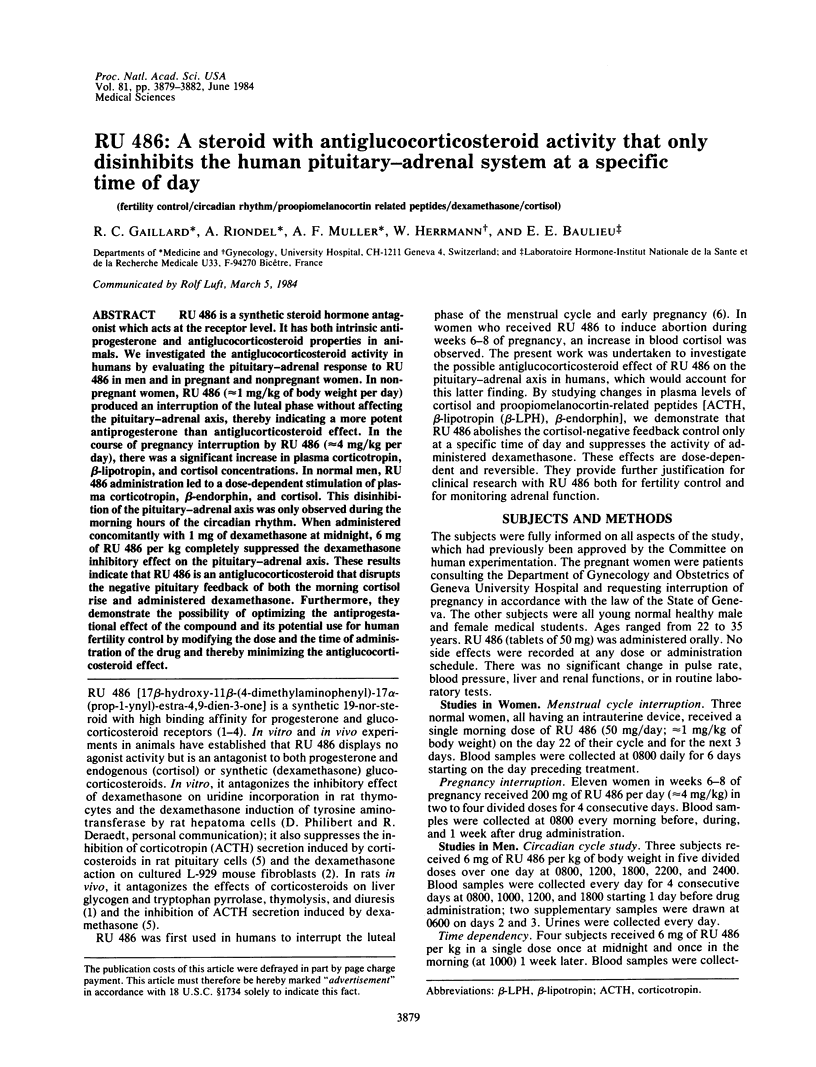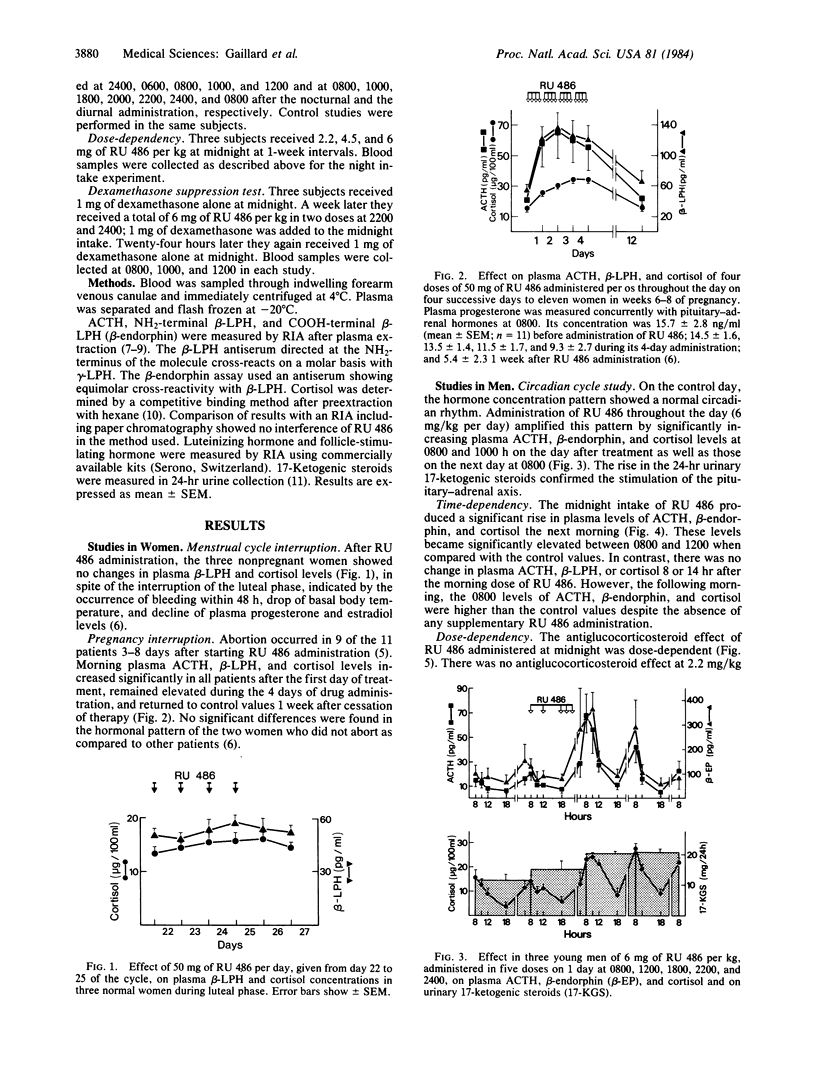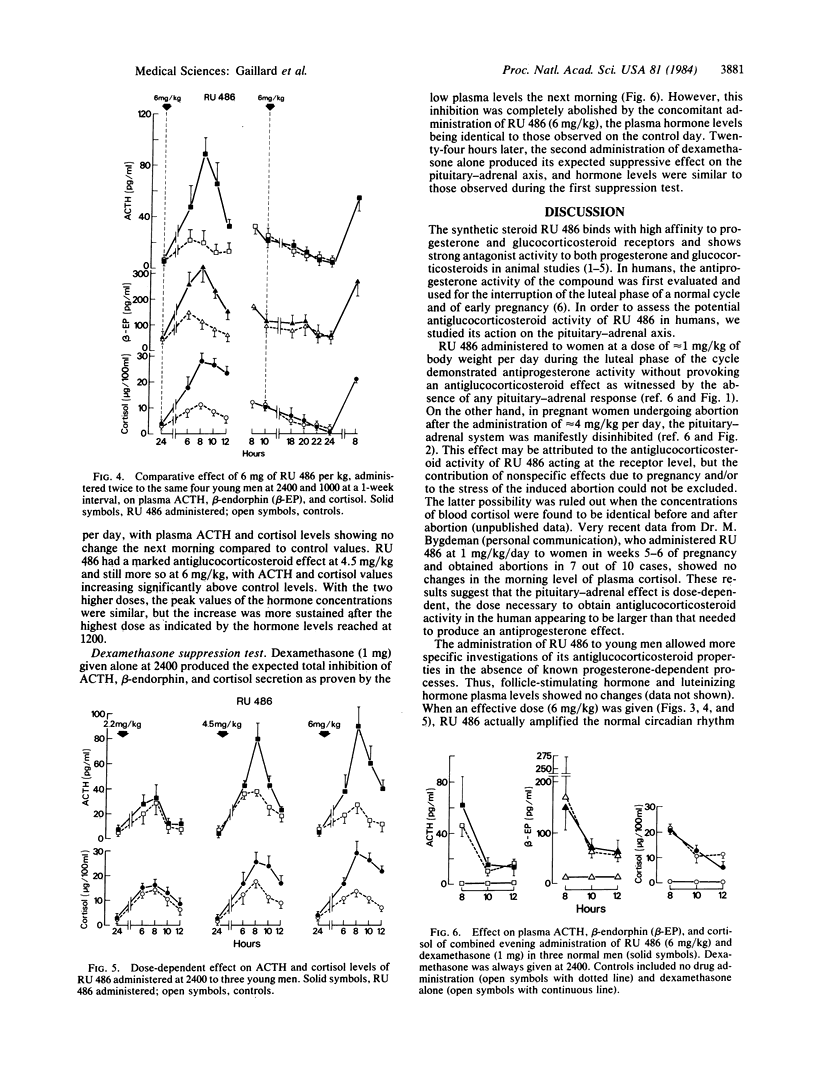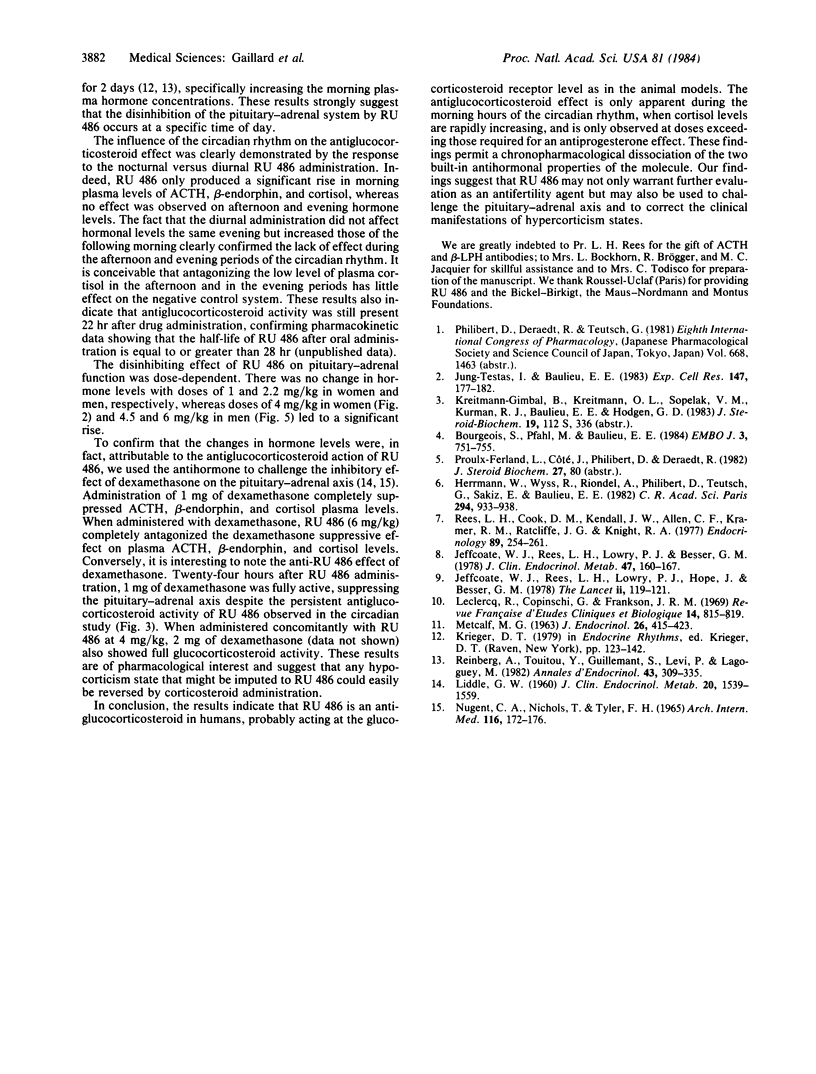Abstract
RU 486 is a synthetic steroid hormone antagonist which acts at the receptor level. It has both intrinsic anti-progesterone and antiglucocorticosteroid properties in animals. We investigated the antiglucocorticosteroid activity in humans by evaluating the pituitary-adrenal response to RU 486 in men and in pregnant and nonpregnant women. In non-pregnant women, RU 486 (approximately equal to 1 mg/kg of body weight per day) produced an interruption of the luteal phase without affecting the pituitary-adrenal axis, thereby indicating a more potent anti-progesterone than antiglucorticosteroid effect. In the course of pregnancy interruption by RU 486 (approximately equal to 4 mg/kg per day), there was a significant increase in plasma corticotropin, beta-lipotropin, and cortisol concentrations. In normal men, RU 486 administration led to a dose-dependent stimulation of plasma corticotropin, beta-endorphin, and cortisol. This disinhibition of the pituitary-adrenal axis was only observed during the morning hours of the circadian rhythm. When administered concomitantly with 1 mg of dexamethasone at midnight, 6 mg of RU 486 per kg completely suppressed the dexamethasone inhibitory effect on the pituitary-adrenal axis. These results indicate that RU 486 is an antiglucocorticosteroid that disrupts the negative pituitary feedback of both the morning cortisol rise and administered dexamethasone. Furthermore, they demonstrate the possibility of optimizing the anti-progestational effect of the compound and its potential use for human fertility control by modifying the dose and the time of administration of the drug and thereby minimizing the antiglucocorticosteroid effect.
Full text
PDF



Selected References
These references are in PubMed. This may not be the complete list of references from this article.
- Bourgeois S., Pfahl M., Baulieu E. E. DNA binding properties of glucocorticosteroid receptors bound to the steroid antagonist RU-486. EMBO J. 1984 Apr;3(4):751–755. doi: 10.1002/j.1460-2075.1984.tb01879.x. [DOI] [PMC free article] [PubMed] [Google Scholar]
- Herrmann W., Wyss R., Riondel A., Philibert D., Teutsch G., Sakiz E., Baulieu E. E. Effet d'un stéroide anti-progestérone chez la femme: interruption du cycle menstruel et de la grossesse au début. C R Seances Acad Sci III. 1982 May 17;294(18):933–938. [PubMed] [Google Scholar]
- Jeffcoate W. J., Rees L. H., Lowry P. J., Besser G. M. A specific radioimmunoassay for human beta-lipotropin. J Clin Endocrinol Metab. 1978 Jul;47(1):160–167. doi: 10.1210/jcem-47-1-160. [DOI] [PubMed] [Google Scholar]
- Jeffcoate W. J., Rees L. H., McLoughlin L., Ratter S. J., Hope J., Lowry P. J., Besser G. M. beta-Endorphin in human cerebrospinal fluid. Lancet. 1978 Jul 15;2(8081):119–121. doi: 10.1016/s0140-6736(78)91506-4. [DOI] [PubMed] [Google Scholar]
- Jung-Testas I., Baulieu E. E. Inhibition of glucocorticosteroid action in cultured L-929 mouse fibroblasts by RU 486, a new anti-glucocorticosteroid of high affinity for the glucocorticosteroid receptor. Exp Cell Res. 1983 Aug;147(1):177–182. doi: 10.1016/0014-4827(83)90282-3. [DOI] [PubMed] [Google Scholar]
- LIDDLE G. W. Tests of pituitary-adrenal suppressibility in the diagnosis of Cushing's syndrome. J Clin Endocrinol Metab. 1960 Dec;20:1539–1560. doi: 10.1210/jcem-20-12-1539. [DOI] [PubMed] [Google Scholar]
- Leclercq R., Copinschi G., Franckson J. R. Le dosage par compétition du cortisol plasmatique. Modification de la méthode de Murphy. Rev Fr Etud Clin Biol. 1969 Oct;14(8):815–819. [PubMed] [Google Scholar]
- METCALF M. G. A rapid method for measuring 17-hydroxycorticosteroids in urine. J Endocrinol. 1963 Jun;26:415–423. doi: 10.1677/joe.0.0260415. [DOI] [PubMed] [Google Scholar]
- NUGENT C. A., NICHOLS T., TYLER F. H. DIAGNOSIS OF CUSHING'S SYNDROME; SINGLE DOSE DEXAMETHASONE SUPPRESSION TEST. Arch Intern Med. 1965 Aug;116:172–176. doi: 10.1001/archinte.1965.03870020012006. [DOI] [PubMed] [Google Scholar]
- Rees L. H., Cook D. M., Kendall J. W., Allen C. F., Kramer R. M., Ratcliffe J. G., Knight R. A. A radioimmunoassay for rat plasma ACTH. Endocrinology. 1971 Jul;89(1):254–261. doi: 10.1210/endo-89-1-254. [DOI] [PubMed] [Google Scholar]
- Reinberg A., Touitou Y., Guillemant S., Levi F., Lagoguey M. Rythmes circadiens et circannuels des résultats d'épreuves fonctionnelles en endocrinologie. Ann Endocrinol (Paris) 1982 Oct-Nov;43(5):309–335. [PubMed] [Google Scholar]


